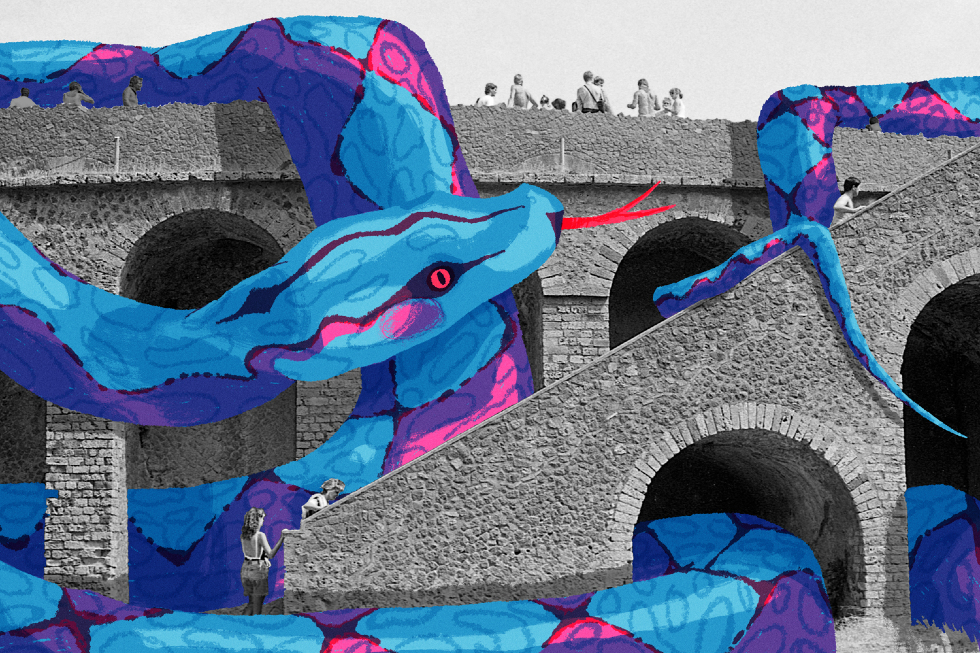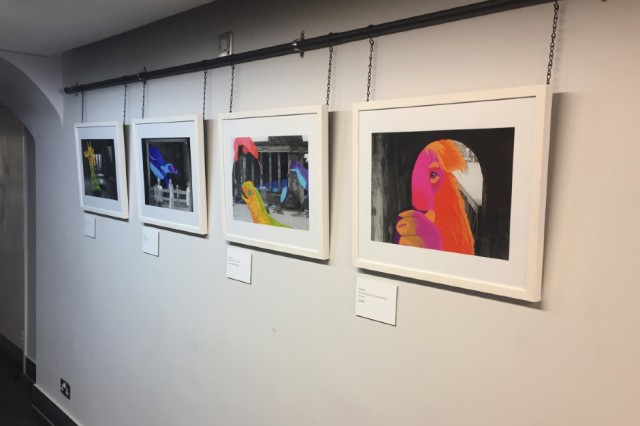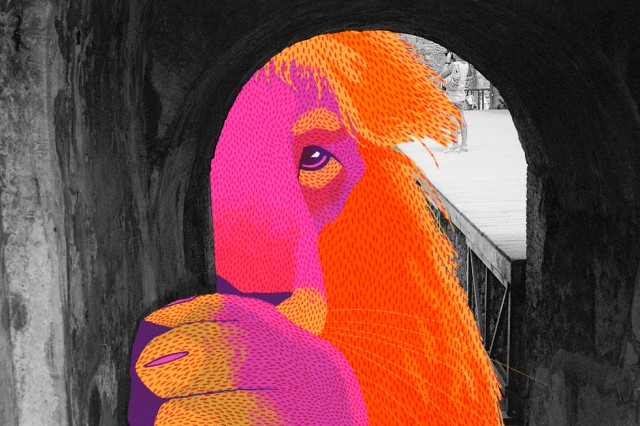Up Deva! Strange Visitors In Town

“Tt became apparent that these photographs of Pompeii could stand in for Chester.” Stephen Clarke on Up Deva!, an exhibition drawing inspiration from sources as varied as past glories, Frankie Howerd comedy, Up Pompeii! and exotic creatures…
Nearly two thousand years ago Pompeii was buried under volcanic ash and debris. The city’s population was wiped out and the buildings vanished from view. Over the centuries the location and even the name of this city were forgotten. In the late sixteenth century Pompeii’s presence became evident when it was excavated first by chance and then, much later, with purpose. By the twentieth century Pompeii was established as a site for tourists to visit. In 1989, it was as a tourist that I took my photographs. The site had become a sprawling collection of ruins covered in vegetation. The negatives of these black and white pictures lay dormant in my archive for 34 years; only recently have they been scanned and explored.
In conversation with illustrator Steph Coathupe it became apparent how these photographs of Pompeii could stand in for Chester. Both places are known for their Roman remains; but whereas one is the ruins of a city in its entirety, the other is a settlement that has incorporated Roman ruin into its fabric as it continually develops as an urban environment. As well as its connection to the ancient empire, Chester is home to one of the world’s leading zoos. It seemed an obvious step to bring together Roman ancestry and a modern zoo, and to let the animals roam the city. Coathupe had been working in the Art and Design department at the University of Chester as part of the AA2A (Artists Access to Art College) scheme. It was in the context of Chester Contemporary, curated by Ryan Gander, that we developed our discussion into a project.
The title of the exhibition, Up Deva! – an homage to the British sitcom Up Pompeii! (1969–1970) that starred Frankie Howerd – sets the tone. Humour was a key feature of this collaboration, born out of a satirical response to the hubris – not uncommon in the world of visual art – surrounding Chester Contemporary. The pictures of ruins are a reminder of past glory, while the inclusion of the brightly coloured animals could be interpreted as referring to the participants, both visitors and exhibitors, as exotic creatures invading this locale. The combination of my photographs and the drawings made by Coathupe bring to mind the characters in the Disney film Jungle Book (1967). In particular the scenes set in the ruins of the abandoned city that is inhabited by monkeys and ruled by King Louie the orangutan.

Not only have the animals taken ownership of the places where men once lived but they start to speak like them too. In the accompanying wall text, a third collaborator, the writer Hannah Harry, makes the connection between Chester and Pompeii as places of tourism. Harry also wrote brief captions for each picture that provide the animals with their own voices. These captions take the form of messages found on the backs of postcards that the animals might have sent to their families. This kind of anthropomorphism can be found in many children’s stories. One such example is the film Bedknobs and Broomsticks (1971) where the enchanted animals that inhabit the island of Naboombu interact with the human travellers of the flying bed with the magical bedknob.
The Chronicles of Narnia by C. S. Lewis (published between 1950 and 1956) conjures up another fantastic land of talking creatures. The god of Narnia is the great lion Aslan. For Up Deva!, Coathupe has a lion (below) introduce the viewers to the scene. Through an archway he welcomes us to the Large Theatre of Pompeii. This is the opening to the exhibition at the Rainbow Tea Rooms. To other scenes are added iguanas that overrun the courthouse, penguins that plunge into a painted mural, and a giraffe that pokes its head from an empty pool in the atrium of a house. These animals added to the photographs are gigantic, another effect of creative magic. The diminutive human tourists in one scene seem unaware of the danger of a huge python (top) that wraps itself around the walls of the amphitheatre.

A sinister vision of wild animals taking control was portrayed in the film Planet of the Apes (1968). Following a nuclear war, the world is ruled by orangutans, gorillas, and chimpanzees. The exhibition has this undercurrent, raising the possibility of what would happen if the city suffered a cataclysm and the animals of the zoo escaped to prowl the streets of Chester. In 1986, such a fate did befall the Ukrainian city of Chernobyl, which became uninhabitable following a nuclear catastrophe. Eventually, the deserted human settlement was overrun by flora and fauna. As with ancient Pompeii, the modern post-apocalyptic landscape of Chernobyl became a tourist destination and a fascination to some artists. Less welcome were more recent visitors to this city in the form of invading Russian military, a reminder of the precarious nature of civilisation.
Stephen Clarke is Senior Lecturer in Art and Design: Critical and Contextual Studies, University of Chester
Up Deva! Steph Coathupe, Stephen Clarke, and Hannah Harry continues at The Rainbow Tea Rooms, Chester until December 2023, and is part of the Chester Contemporary Fringe





